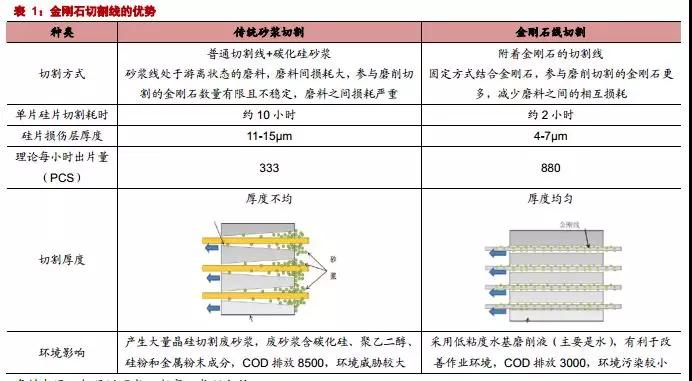 (2) Analysis of substitution degree 1. Sapphire square cutting and slicing market, diamond wire cutting has basically replaced traditional cutting technology. Diamond wire was applied to sapphire processing earlier. The main reason is that the hardness of sapphire is second only to diamond, and the hardness of cutting tool. The requirements are extremely high. The diamond wire uses the hardest diamond as the cutting abrasive, so it has an irreplaceable efficiency and economic advantage in the sapphire cutting market.
(2) Analysis of substitution degree 1. Sapphire square cutting and slicing market, diamond wire cutting has basically replaced traditional cutting technology. Diamond wire was applied to sapphire processing earlier. The main reason is that the hardness of sapphire is second only to diamond, and the hardness of cutting tool. The requirements are extremely high. The diamond wire uses the hardest diamond as the cutting abrasive, so it has an irreplaceable efficiency and economic advantage in the sapphire cutting market. 2, single crystal silicon and polysilicon A, single crystal silicon chip market, diamond wire is rapidly replacing the traditional cutting process diamond wire for cutting single crystal silicon has improved cutting efficiency, reduced material loss, increased filming rate, reducing pollution, etc. Therefore, it is rapidly replacing the traditional cutting process. According to ITRPV, after 2018, in the monocrystalline silicon wafer market, the market penetration rate of the diamond wire cutting process (current market demand / potential market demand) will exceed 70%. Longjing, a leading monocrystalline silicon company, has applied diamond wire slicing technology throughout the plant. B, polysilicon chip market, comprehensive conversion to diamond wire cutting technology and conversion progress beyond the industry's original expectations Polysilicon cutting using diamond wire mainly has two technical problems: First, the heterogeneous node of the ingot crystal will cause the problem of disconnection, the second is The damaged layer of diamond wire cutting is relatively shallow, which makes the traditional HF/HNO3 texturing technology unable to produce good optical properties. At present, the leading enterprises in the polycrystalline industry such as Poly GCL have overcome the above problems to a large extent through the technical means such as black silicon, and have introduced the related silicon wafer cutting polycrystalline silicon products. In 2017, the solar polysilicon cutting method was fully converted to the diamond wire cutting method, and the conversion progress exceeded the industry's original expectations. In summary, due to its cutting efficiency, material loss, environmental protection, product quality, operating costs, etc., the diamond wire has basically replaced traditional cutting technology in the fields of sapphire square and slicing, square silicon core cutting, etc.; The open and cut-off market has developed into a mainstream process; in the market of monocrystalline silicon chips, it is rapidly replacing traditional cutting technology; there are certain technological breakthroughs in the field of polysilicon chipping. With the advancement of technology, it is expected that the penetration rate will gradually increase in the next few years. . Second, the downstream photovoltaic industry, sapphire industry development status The diamond wire is currently mainly used in the field of silicon materials, sapphire material cutting, and a small number of applications in the cutting of magnetic materials. (1) Rapid growth of the photovoltaic industry brings rapid growth of the industry At present, about 80% of the domestic diamond cutting lines enter the photovoltaic industry through downstream silicon wafer manufacturers, especially after the technical barriers are removed, the premium capability of the silicon wire for silicon wafer cutting is obtained. Improvement is the core of the elasticity of demand in the industry. The production capacity of China's top ten silicon wafer enterprises accounts for more than 70% of the country's total production capacity. The concentration of downstream industries is high and customers are sticky.
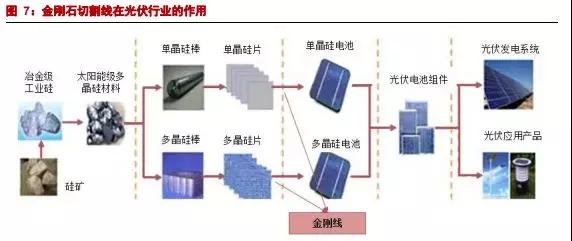 According to the statistics of the Photovoltaic Industry Association, the penetration rate of single diamond in the 2017 diamond wire has reached 100%, and the penetration rate of polysilicon in the polysilicon has reached 35%. In the future, the growth of the diamond wire in the photovoltaic field mainly comes from three aspects:
According to the statistics of the Photovoltaic Industry Association, the penetration rate of single diamond in the 2017 diamond wire has reached 100%, and the penetration rate of polysilicon in the polysilicon has reached 35%. In the future, the growth of the diamond wire in the photovoltaic field mainly comes from three aspects: 1) Increase in new installed capacity in the PV market;
2) The increase of monocrystalline silicon in the silicon wafer market;
3) The diamond wire has an increase in the permeability of polysilicon.
The global PV market is growing strongly, with China accounting for half of the country. In 2017, the installed capacity of the global PV market reached 102GW, an increase of over 37% year-on-year, and the cumulative PV capacity reached 405GW. In 2017, the scale of new PV power plants in China was 52.83GW, a year-on-year increase of more than 53.6%. Among them, the installed capacity of new distributed PV power plants has exceeded 19GW, which is more than 360% year-on-year. The total installed capacity of distributed PVs in the past five years is increasing in installed capacity. The proportion is over 36%. Monocrystalline silicon: The future demand for diamond wire mainly comes from the increase in the market share of monocrystalline silicon in silicon wafers. According to CPIA data, monocrystalline silicon has a market share of 31% in the wafer market in 2017. Up to 100%, so the future development of monocrystalline silicon wafers mainly comes from the increase in the market share of monocrystalline silicon in silicon wafers. According to the data of China's Photovoltaic Industry Development Roadmap (2017 edition), the market share of monocrystalline silicon will reach 46% by 2020, and the market share will exceed 50% by 2025.
 The reasons for the obvious and sustainable trend of single crystal substitution polycrystal in the future are as follows: 1) At present, the cost gap of single crystal polycrystals is narrowing, and there is still room for reduction in single crystal. According to the latest data, the average spot price of polycrystalline silicon wafers (156mm × 156mm) is 0.6 US dollars per piece, and the average weekly price of monocrystalline silicon wafers (156mm × 156mm) is 0.69 US dollars per piece. The gap between the two is shrinking. 2) In terms of efficiency, the conversion efficiency of single crystal silicon cells and the power generation efficiency of single crystal silicon power plants are higher. The conversion efficiency of monocrystalline silicon cells reached 21.3% in 2017, and the highest conversion efficiency of P-PERC continued to break. The highest conversion efficiency of Jingke reached 23.45%, and Longji reached 22.7%. In contrast, the conversion efficiency higher than polysilicon is 19.2%. Moreover, the power generation efficiency of the monocrystalline silicon power station is high. According to the data of the industrial information network, the actual power generation capacity of the monocrystalline silicon power plant is about 6% more than that of the polysilicon power station in the 25-year life cycle.
The reasons for the obvious and sustainable trend of single crystal substitution polycrystal in the future are as follows: 1) At present, the cost gap of single crystal polycrystals is narrowing, and there is still room for reduction in single crystal. According to the latest data, the average spot price of polycrystalline silicon wafers (156mm × 156mm) is 0.6 US dollars per piece, and the average weekly price of monocrystalline silicon wafers (156mm × 156mm) is 0.69 US dollars per piece. The gap between the two is shrinking. 2) In terms of efficiency, the conversion efficiency of single crystal silicon cells and the power generation efficiency of single crystal silicon power plants are higher. The conversion efficiency of monocrystalline silicon cells reached 21.3% in 2017, and the highest conversion efficiency of P-PERC continued to break. The highest conversion efficiency of Jingke reached 23.45%, and Longji reached 22.7%. In contrast, the conversion efficiency higher than polysilicon is 19.2%. Moreover, the power generation efficiency of the monocrystalline silicon power station is high. According to the data of the industrial information network, the actual power generation capacity of the monocrystalline silicon power plant is about 6% more than that of the polysilicon power station in the 25-year life cycle.  Polysilicon: The future demand for diamond wire mainly comes from the increase of permeability in polysilicon. Currently, polysilicon has a high market share in the wafer market, but most of them are still mortar wire cutting, and the penetration rate of diamond wire cutting is low. According to CPIA data, the market share of polysilicon in the silicon wafer market reached 69% in 2017, and the diamond wire cut ratio accounted for only 35%. Therefore, the future development of the polysilicon wafer diamond line mainly comes from the penetration rate of the diamond wire in the polysilicon wafer. Improvement.
Polysilicon: The future demand for diamond wire mainly comes from the increase of permeability in polysilicon. Currently, polysilicon has a high market share in the wafer market, but most of them are still mortar wire cutting, and the penetration rate of diamond wire cutting is low. According to CPIA data, the market share of polysilicon in the silicon wafer market reached 69% in 2017, and the diamond wire cut ratio accounted for only 35%. Therefore, the future development of the polysilicon wafer diamond line mainly comes from the penetration rate of the diamond wire in the polysilicon wafer. Improvement. Before 2015, there were two major difficulties in diamond cutting from Diamond Wire:
1) Hard spots present in the ingot crystal may cause wire breakage during the cutting process;
2) The damage layer is shallow, and it is difficult to prepare the anti-reflection suede by the current acid wet-fabrication technique, and the surface reflectance of the silicon wafer is relatively high.
With the technical upgrade, the problem of the reflectivity of the diamond-cut polycrystalline crystal has been basically solved. As the polysilicon ingot impurity control technology is improved, the wire breakage problem can be solved. The black silicon technology + diamond wire cutting technology solves the suede problem of the silicon wafer, which can improve the battery conversion efficiency and reduce the battery cost. Compared with the previous sand cutting, the production efficiency of the diamond wire cutting polycrystalline machine is increased by more than 50%, the unit silicon consumption is reduced by more than 20%, and the vertical manufacturing cost can be reduced by more than 26%. This is the most important cost reduction measure in recent years. Leading manufacturer diamond wire cut polycrystalline production capacity accounted for 80%-90%, polysilicon diamond line penetration rate is rapidly increasing. At the end of 2017, GCL-Poly Diamond Line's silicon wafer production capacity accounted for 80%-90%, and it is expected to achieve 100% in 2018. According to the data of China's Photovoltaic Industry Development Roadmap (2017 edition), the penetration rate of diamond wire in polysilicon in 2017 has reached 35%. It is expected that the penetration rate of diamond wire will reach 85% in 2018 and 95% in 2019, 2020. It will achieve 100% in the year, the global corresponding cut polycrystalline diamond line space is 43.31 million kilometers, and China's corresponding cut polycrystalline diamond line space is 17.72 million kilometers. (2) Sapphire cutting market In the field of sapphire cutting, because the sapphire Mohs hardness is large, the traditional mortar cutting and resin diamond wire cutting strength is not enough to effectively cut the sapphire. At present, the electroplated diamond wire has completely replaced the traditional mortar cutting. The electroplated diamond wire is mainly used for the substrate and square section of sapphire. The demand for electroplated diamond wire for sapphire cutting depends mainly on the market demand for sapphire materials. The market demand for sapphire materials depends mainly on the needs of the LED market. The 2016-2021 China led drive power market prospects and investment development strategy research report released by China Industrial Research Institute is expected to increase in the future as the global energy crisis intensifies, residents' environmental awareness increases, LED lighting technology advances and costs decrease. In the year, the LED lighting industry will continue to grow at a relatively fast rate. By 2020, the global LED lighting market will exceed US$70 billion, and the CAGR of 2015-2020 will be close to 30%. (II) Core enterprises in the domestic market At present, the industry pattern of the global electroplating diamond line is mainly monopolized by Japan, representing the company AsahiDiamond and Nakamura. Chinese local enterprises may be in a catch-up position before 2016, but from this year's situation, in addition to some differences in quality stability, other links have been basically flattened, and product prices have clear advantages, in fact, quite a lot of downstream Single crystal enterprises have been using a large number of domestically produced diamond wires for production, and the pace of Japanese and Korean companies' production expansion is slower than that of domestic companies, and it is unable to keep up with the expansion of domestic PV companies in the past two years. We have divided the domestically mature enterprises into three echelons. The first echelon is Muller New Materials, Nanjing Sanchao and Dongni Electronics. This is a good domestic market share and the most favorable downstream customers. Enterprises, and after completing the listing in 2017, have received sufficient capital investment to expand, and the growth of market share in 2018 will be more clear. The second echelon includes Yu Diamond and Yang Ling Mei Chang. These companies have a considerable scale of diamond fiber capacity, and have a certain degree of customer resources. In some areas, there are customer first-mover advantages, but the overall sales volume and customer coverage are slightly less than the first echelon. The capacity increase in the last two years is not as clear as the first echelon. The third echelon is represented by companies such as Stellar Technology, Huanghe Cyclone, Yicheng Xinneng, Ruiqi New Materials and other original superhard materials, wire materials and cutting materials. These companies have extended to the diamond line field through the industrial chain extension, but currently The production capacity is relatively small, and the market share is relatively low. Some enterprises are operating in the resin diamond line. Compared with the electroplating diamond line, the current competition is not dominant, and some enterprises have some other business burdens. We will then make a brief summary of the current core companies in the industry:
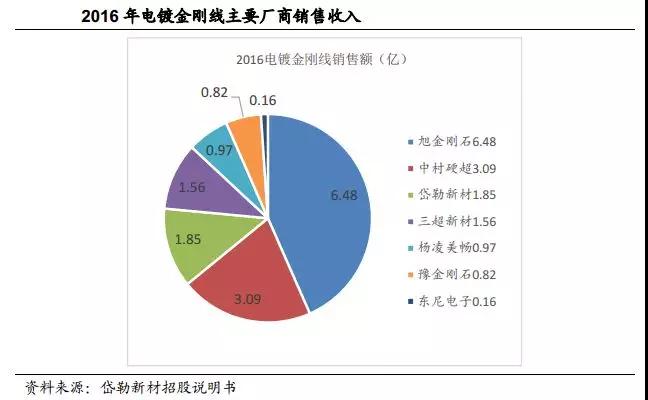
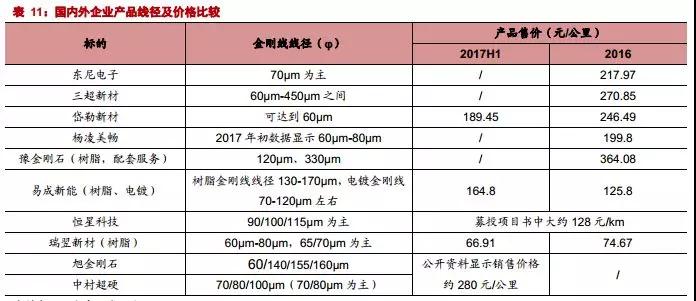 In the domestic enterprises, Yangling Meichang, Tony Electronics, Sanchao New Materials, and Muller New Materials have a price of about 200-270 in 2016. Among them, the price of the new products in the first half of 2017 decreased by about 23% year-on-year. In 2017, the domestic enterprise price is expected to be between 150-200 yuan/km; the price of foreign companies represented by Asahi Diamond and Nakamura Superhard is as high as 280 yuan/km, and the price advantage is remarkable. Proper cost control and enhance the competitiveness of domestic enterprises. With the improvement of production technology, mass production of domestic enterprises, competition has intensified, and product prices have continued to decline. In the future, as the production capacity of domestic enterprises continues to expand, product prices will fall or become a trend, and excellent cost control companies are expected to stand out. According to our statistics, the gross profit margin of domestic enterprises is about 50%. For example, the gross profit margin of Muller new products reaches 46% and the net profit margin is 22%. Among foreign companies, the revenue of Asahi Diamond Diamond Line has continued to decline in recent years, and its competitiveness has been declining. Nakamura Superhard has experienced significant fluctuations in its business in recent years. The business net interest rate has a large amplitude and its cost control ability is limited. It can be seen in King Kong. The line sector is less competitive than domestic companies.
In the domestic enterprises, Yangling Meichang, Tony Electronics, Sanchao New Materials, and Muller New Materials have a price of about 200-270 in 2016. Among them, the price of the new products in the first half of 2017 decreased by about 23% year-on-year. In 2017, the domestic enterprise price is expected to be between 150-200 yuan/km; the price of foreign companies represented by Asahi Diamond and Nakamura Superhard is as high as 280 yuan/km, and the price advantage is remarkable. Proper cost control and enhance the competitiveness of domestic enterprises. With the improvement of production technology, mass production of domestic enterprises, competition has intensified, and product prices have continued to decline. In the future, as the production capacity of domestic enterprises continues to expand, product prices will fall or become a trend, and excellent cost control companies are expected to stand out. According to our statistics, the gross profit margin of domestic enterprises is about 50%. For example, the gross profit margin of Muller new products reaches 46% and the net profit margin is 22%. Among foreign companies, the revenue of Asahi Diamond Diamond Line has continued to decline in recent years, and its competitiveness has been declining. Nakamura Superhard has experienced significant fluctuations in its business in recent years. The business net interest rate has a large amplitude and its cost control ability is limited. It can be seen in King Kong. The line sector is less competitive than domestic companies. 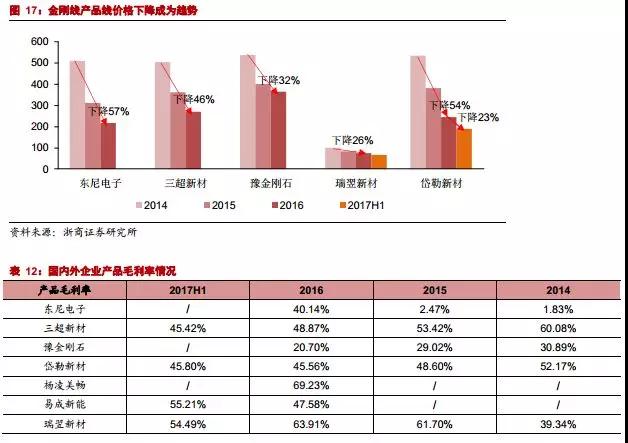
For use in outward opening windows allowing access to window locks and winders.Pet safety enclosure perfect for indoors and outdoors.
1.The multi size: 19x10cm 20cmx30cm, 30cmx40cm suitable for most ordinary family doors.
2.Install Easily: only need to install on the door (suitable position) Completely assembled for immediate use.
3.It's recommended for small pets and it can be moved from one place to another in the House if need.
Pet Door,Aluminum Pet Door,Pet Door For Screen Door,Pet Flap For Screen Door,Porthole screen
Hebei Charlotte Enterprise Co., Ltd. , https://www.cnscreening.com